A monthly e-newsletter from UMass Extension for landscapers, arborists, and other Green Industry professionals, including monthly tips for home gardeners.
To read individual sections of the message, click on the section headings below to expand the content:
Featured Plant
Acer griseum, Paperbark Maple
xxxxx
Acer griseum is a small- to medium-sized deciduous tree, slowing growing to 20 – 30’ tall and 15 -20’ wide. When the tree is about six years old, the bark begins exfoliating in cinnamon-colored plates that remain on the tree and contrast with the tan to rose-brown inner bark. Bark quality can be variable, ranging from dull brown to bright orange, and from exfoliating to smooth. Twigs are brown-red clothed with gray pubescence (fine hairs), becoming exfoliating and more lightly colored as they enlarge to young branches. Most branches that have a diameter of 1½ inches and larger will have exfoliating bark.
Paperbark maple has opposite and compound, 3-lobed trifoliate leaves. The 3 leaflets are each up to 2 to 3 inches long with three elongated pairs of lobes down the length of the leaf. Leaves are green above, but blue-green to gray-green with fine hairs beneath. Fall foliage color varies from year to year, from tree to tree, and from location to location. The color ranges from shades of yellowish-green to bronze green, to showy shades of reds and red-oranges. Fall color is more spectacular in the East than in the Midwest and the South.
Paperbark maple performs best on moist, well drained soils. It is adaptable to a wide range of soils and soil pH, but is intolerant of drought, and prefers full sun to part shade. Pests and problems can include verticillium wilt, crown gall, bagworm, and anthracnose. Paperbark maple is native to Central China and is hardy to USDA zones 4 – 8.
This is an excellent small tree for small properties and is ideal near a deck or patio where its ornamental features can be appreciated. Paperbark maple can be used singly as a specimen landscape plant, a small lawn tree, or in group plantings in a shrub border or other group plantings. During the winter the cinnamon-colored, exfoliating bark accentuated by snow is an element of interest in the winter landscape.
There is a lot of variability within the species for bark quality, cold hardiness, and vigor. Paperbark maple is difficult to propagate due to poor seed quality and being very difficult to root. Although propagation issues have meant it had poor availability in the past, Acer griseum is becoming more readily available in commerce. 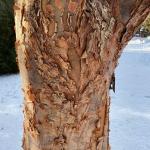

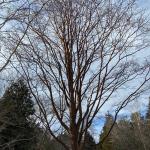

Geoffrey Njue, UMass Extension Sustainable Landscapes Specialist
Questions & Answers
Q: The wet heavy snows in early December weighed down branches on many trees and shrubs, splayed open specimen arborvitaes, and flattened young yews. Some new plants were crushed under the snow sliding off the garage roof. I wasn’t sure what to do so I left them alone. Now, some have rebounded but others, like the arborvitae, remain splayed open. As we approach the end of winter, I worry about similar storms and wonder what I should do to help these plants survive. Should I shake the wet heavy snow off as soon as possible? Will the arborvitae and yew regain their previous shape on their own when spring comes? Should I stake and tie the plants now and every fall? Make tee-pees out of plywood for those next to the garage? Or should I just leave them alone? What is the best strategy to avoid this issue when selecting plants for future plantings?
A: The best approach to removing snow and ice from plants after a storm is to let nature do it whenever possible. Branches that have been splayed open but not broken typically rebound once the snow has been removed, particularly when the load is of short duration. Tension and compression wood within trees and shrubs help the branch or trunk return to a vertical position. The speed and ability of a plant to do this depends on a variety of factors including species, degree and duration of bending, and, of course, whether or not breakage has occurred. Shaking or vigorously raking snow and ice off plants can do more harm than good by further damaging the wood and breaking branches.
However, when additional snow is predicted or the conditions that favor melting are not in the forecast, the gentle removal of snow can be beneficial. Gentle is key. Use a soft broom and sweep the snow upwards off the branches and away from the center of the plant. Avoid applying further downward pressure to branches. Do not shake branches which can further damage the already compromised wood. Remove snow as soon as possible after a storm, before it packs and freezes within the network of leaves and needles. Once branches are locked into accumulated snow, it is best to wait until the snow melts naturally rather than try to chip away, or tug and pull at the branches. Accumulations of ice are best left to melt naturally.
Tying and staking can help reduce damage from subsequent storms. Use soft rope, fabric ties, innertubes or arborists tying material to fasten the plants to a stake or to bring multiple leaders together to support one another. These soft materials will reduce chafing and bark damage and will allow for some movement within the tie. Be sure to release the ties when the threat of storms has passed, and certainly within six months to a year.
Any stems that have broken or split open should be removed as soon as possible after the weight or load has been lifted. Clean cuts will heal more efficiently than ragged breaks. Always follow good pruning practices, cutting back to the main trunk or side branches rather than leaving stubs, and call in a certified arborist for large cuts and damage that is out of reach.
Pruning: In general, trees with sharply ascending branches and narrow crotches between branch and trunk are more susceptible to breakage. These tight unions which are ‘V’ rather than ‘U’ shaped often have included bark (bark that is compressed between the two stems), creating a weak point which is prone to splitting under stress. Trees with wide, spreading canopies and decurrent branch patterns which result in increasingly smaller and more numerous branches at the tips, as well as those with large, long limbs, collect ice and snow on these surfaces and may be prone to failure in extreme conditions. Trees and shrubs that are one-sided from growing close to structures, along woodland edges, or near other plants are most likely to bend under a lopsided load. Pruning young trees to establish a central leader, open branching habit and balanced form can make a big difference in their ability to withstand unfavorable conditions. Look to local public gardens, garden clubs, universities, arborist associations, and arboreta for pruning workshops to help build skills. Count on a certified arborist to help improve structure in larger existing trees.
Protecting: Existing trees and shrubs can be provided protection as winter approaches. Those with multiple leaders, flat-topped shrubs, and those with broad spreading forms can be tied together in late autumn or early winter to keep them from splaying open. As mentioned above, it’s important to use a flexible tying material like arborist tie, cotton rope, inner tube, or stretchy fabric like pantyhose or cotton cloth. These soft materials will reduce chafing and bark damage and will allow for some movement within the tie. When binding multiple trunks together to prevent from splaying, start by tying the twine to the trunk or a low branch. Wind the tying material up and around the plant containing all the branches within the spiral and gently bringing branches towards the center until you reach the top, then spiral back down to the base again and tie off. Don’t pull the branches in too tightly - you want to support them while still allowing for good air circulation and some movement. If the plant you are protecting is susceptible to winter burn, a layer of burlap wrapping can be included under the tying material to afford protection from wind, sun and salt spray. Remove wraps and ties as soon as the danger of storms passes in spring and well before new growth begins.
Tee-pees made of 2X4’s and plywood are standard plant protection in cold climates. If you’ve inherited a foundation planting that has plants in the snow zone below the eaves, it’s worth erecting these contraptions to protect them. Make sure they are sturdy and are staked down to prevent them from blowing over or collapsing under a heave snow load. Put tee-pees up after leaf cleanup is complete.
The best long-term strategy to avoid damage lies in proper plant selection and placement, as well as pruning. Certain plants, like birch (Betula sp.) and white pine (Pinus strobus), are susceptible to damage from snow and ice loads. Many deciduous shrubs are flexible enough to withstand some bending and will easily rebound once the pressure is relieved – forsythia (Forsythia sp.), winterberries (Ilex verticillata), inkberry (Ilex glabra), summersweet (Clethra alnifolia), mountain laurel (Kalmia latifolia) and low junipers (Juniperus sp.) and yew (Taxus sp.) are good examples of shrubs that usually rebound well. Trees and shrubs with brittle wood or poor forms tend to fare poorly. Evergreens provide a surface for snow to accumulate on, yet many of the evergreens that we grow have evolved in cold climates and are adapted to withstand snow loads. Spruce (Picea sp.) and fir (Abies sp.), for example, have a conical or excurrent form made up of layered branches which are increasingly smaller at the top, as well as at the tip of each branch. Additionally, larger branches are often slightly pendulous and flexible. This structure allows them to flex and shed the snow. White pines have very flexible young branches which bend readily and shed snow, but the older branches are less flexible and frequently break under heavy snow or ice loads. When the upper branches fail, they often cascade downward ravaging the branches below. Fluctuations in climate and increasingly wet and heavy snow accumulations, as well as damaging ice storms, make them hard to use in our designed landscapes. Multi-stemmed forms of juniper (Juniperus sp.) and arborvitae (Thuja sp.) often fall victim to the weight of winter precipitation. Choose single leader specimens, or prune to that form, when adding upright evergreens.
Typical foundation plantings put plants right in harm’s way - exactly where snow and ice land after picking up speed in the descent from the roof above. Avoid planting in this area and move valuable plants out of this zone. This is also true for plants placed near paths and driveways – snow piles from shoveling, snowblowers and plows not only adds structural stress but the added hazard of deicing materials. Keep valuable plants out of the zones used for snow storage. True, these plants can be protected with wooden structures to divert the snow and protect them, but, unless you really enjoy the aesthetics of the protective structures, love installing and removing them in fall and spring, and have abundant storage space, isn’t it better to put plants where they are safe from a known risk and appreciated for their own structure and form? The snowy season, after all, lasts from November into early April – half the year. Better invest in a well-planned landscape and properly prune trees and shrubs which are better suited to withstand New England winters than to continually fight and repair damage.
Joann Vieira, Director of Horticulture, The Trustees of Reservations
Trouble Maker of the Month
Now is a Great Time to Scout for Bagworms!
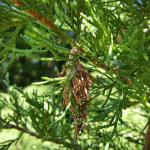 The bagworm, Thyridopteryx ephemeraeformis, is a Lepidopteran (moth) pest commonly encountered feeding on arborvitae and juniper in New England. However, this insect can be found on many deciduous and evergreen trees and shrubs. Many professionals noticed increased numbers of bagworms present in Massachusetts landscapes and urban forests in 2019. While this may not necessarily mean these insects will be plentiful in 2020, it may be a good idea to have this insect on your scouting radar. Now is a great time to remove overwintering bagworm “bags” from host plants and destroy them before the eggs, sheltered within, hatch in mid-June.
The bagworm, Thyridopteryx ephemeraeformis, is a Lepidopteran (moth) pest commonly encountered feeding on arborvitae and juniper in New England. However, this insect can be found on many deciduous and evergreen trees and shrubs. Many professionals noticed increased numbers of bagworms present in Massachusetts landscapes and urban forests in 2019. While this may not necessarily mean these insects will be plentiful in 2020, it may be a good idea to have this insect on your scouting radar. Now is a great time to remove overwintering bagworm “bags” from host plants and destroy them before the eggs, sheltered within, hatch in mid-June.
The larvae (caterpillars) of this moth species form "bags" or cases made from plant foliage and silk. These may appear to be normal plant parts to the untrained eye. Larvae will carry these cases while they defoliate the host plant. After the larva hatches from its egg, it is capable of dispersing to surrounding plants using the ballooning technique, similar to that of gypsy moth caterpillars. Tiny bagworm caterpillars will spin a silken thread and disperse with the assistance of the wind. If the bagworm caterpillar lands on a suitable host, it spins a tiny cocoon-like bag to which it attaches pieces of plant leaves, needles, and twigs. Only the head and thorax of the caterpillar comes out of the bag, which is dragged along behind the insect as it moves. Seven instars (developmental stages between molts) have been reported for the caterpillars.
Mature bagworm larvae will attach their bag to a branch with a strong silk band. Pupation occurs within the bag. Adult bagworms are fascinating. Adult females spend their entire lives inside their bags and are wingless and do not look like a typical adult moth. Adult males emerge from their bags as freely flying moths that are hairy and dark in color with membranous wings. Males reportedly live 1-2 days and adult females may live for a couple of weeks.
Injury to hosts can be quite severe when populations are high and complete defoliation can occur. However, historically, bagworms have not been an annual pest in Massachusetts.
This species of bagworm is native to North America. It is distributed throughout the eastern United States to Nebraska and has historically had a northern limit to its range described as southern Michigan and in most cases at points similar in latitude. However, within the last decade, bagworms have been detected in new areas such as parts of northern Michigan and southern Ontario.
Some recent studies have considered how climate change may impact the northern boundary of this insect’s known range. One such study found that over-winter egg mortality is the biggest constraint on bagworm survival beyond their northern range limit. Egg mortality over the winter is directly related to temperatures falling below bagworm eggs’ physiological limit (threshold). Therefore, as climate change is predicted to increase minimum winter temperatures, this species may be impacted by that change. That said, predicting changes in insect herbivores due to climate change is incredibly complex. Entomologists need to consider a multitude of different factors, including but not limited to: temperature, photoperiod, individual insect herbivore phenotypic (expression of a particular trait or physical appearance) and genotypic (genetic makeup of an organism) flexibility, etc.
For more information about bagworms, including management options, visit the newly updated Bagworm Fact Sheet.
Further Resources Include:
Bale, J. S., et al. (2002). Herbivory in global climate change research: direct effects of rising temperature
on insect herbivores. Global change biology, 8(1), 1-16.
Lynch, H. J., et al. (2014). How climate extremes—not means—define a species' geographic range
boundary via a demographic tipping point. Ecological Monographs, 84(1), 131-149.
Rhainds, M., & Sadof, C. (2009). Control of bagworms (Lepidoptera: Psychidae) using contact and soil-
applied systemic insecticides. Journal of economic entomology, 102(3), 1164-1169.
Tawny Simisky, Extension Entomologist, UMass Extension Landscape, Nursery, & Urban Forestry Program
Garden Clippings Tips of the Month
March is the time to:
- Assemble materials necessary for starting seeds indoors: flats or other containers of various sizes, sterile soilless germination mix, container labels and markers, heat source, light source, and watering supplies. Thoroughly clean any containers previously used for planting, disinfect them by soaking for about 30 minutes in a 1 part bleach in 9 parts water solution, and follow up with rinsing containers in clean water and air drying.
- Sow vegetable and herb seeds indoors. Basil, dill, chives, cilantro, oregano, and parsley are all candidates for early sowing indoors—they can be kept as container plants in the kitchen and moved to the patio when weather improves. Early March is also a good time to start cold-tolerant cole crops such as broccoli, cabbage, cauliflower, collards, and kale in preparation for hardening off and transplanting into the garden when they are about 5 to 6 weeks old. Sow eggplant and pepper seeds later in the month, a week or two before starting tomatoes, for garden-ready transplants in late May or early June.
- Invest some time in houseplant maintenance. Use a soft, moist cloth to remove any dust from foliage plants; dust can hinder photosynthesis. Pinch back shoots of geraniums and coleus that may have become leggy in lower winter light conditions. Monitor more frequently for insect pests and watering needs as daylength and sunlight intensity increase. Fertilize plants showing new growth with a water-soluble or slow-release fertilizer. And begin repotting potbound plants as needed, in a mix containing coarse materials that permit drainage.
- Perform tool maintenance. Clean, disinfect, and sharpen loppers, pruning shears, and handsaws. Be aware that bleach can corrode the metal blades of pruning tools; the household cleaner Lysol used at full strength has been demonstrated to be an effective, less corrosive disinfectant. Oil wooden handles of hoes and trowels with linseed oil, and spray paint with bright colors the handles of any small tools that are apt to get lost in the garden.
- Renovate old blueberry bushes. Do this gradually, over a period of three years, to avoid sacrificing too much fruit production. Each year, cut back one third of the oldest stems to ground level. This is also a good time to prune raspberries, grapes, and apple trees. Annual pruning is essential for getting abundant and high-quality fruit production. While the pruning tools are out, survey landscape trees and shrubs for winter-damaged limbs. Remove those that can be safely reached from the ground but consult a certified arborist to handle branches higher up.
- Cut back ornamental grasses before spring growth begins. Leaving the old foliage in place over winter helps insulate the crown of grass plants, but if left too long in the spring, this same foliage will hinder warming and new growth. While working, be mindful that foot traffic within the garden and on the lawn can cause compaction of wet soil and result in poor growth of turf grass and herbaceous perennials, trees, and shrubs.
- Enjoy the earliest spring flowers in bloom: snowdrops, snow crocus, and winter aconite. Evaluate where more of these early season bloomers can be naturalized in the yard, and either divide large existing clumps after flowering is finished and replant or plan to order additional bulbs, corms, and tubers in the fall.
- Save wood ash from the wood stove or fireplace to use as a valuable soil amendment. Wood ash is a good source of potassium and calcium, and delivers smaller amounts of phosphorus, magnesium, and micronutrients important for plant growth. Screen ash through quarter-inch mesh and scatter small amounts lightly over lawns and gardens, even while they are snow covered. Ideally, have a soil test conducted to know soil pH prior to applying wood ash, since the calcium carbonate in wood ash increases soil pH. Go the UMass Soil and Plant Nutrient Testing Lab's web page for info on how to submit a soil sample for testing: http://ag.umass.edu/services/soil-plant-nutrient-testing-laboratory
- Learn and be inspired by a seminar, webinar, symposium or home and garden show. March is a month filled with opportunities to attend lectures and classes throughout the state.
Jennifer Kujawski, Horticulturist
Guest Article
Neonicotinoids + Varroa Mites Impact Winter Bee Health
This article is an excerpt from “The Research Buzz” – a quarterly column summarizing the latest in honey bee research. It is published in the Massachusetts Beekeeping Association newsletter, and also on the UMass Extension website. You can read the full article here.
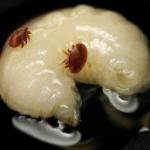 This past spring, an international team of researchers published a paper testing whether neonicotinoid exposure and Varroa parasitism interact to affect the health of winter bees (long-lived bees born in autumn, who are crucial for overwintering survival). The aptly named Varroa destructor mite is a ubiquitous honey bee parasite that arrived in the US from Asia in 1987 and has dramatically impacted bee health (learn more about Varroa here and here). The researchers found that winter bees exposed to the neonicotinoid thiamethoxam and parasitized by Varroa as pupae weighed less at emergence and died sooner than un-exposed and un-parasitized bees. Neonicotinoid exposure alone did not affect emergence weight or lifespan. Varroa parasitism alone did reduce emergence weight and shorten lifespan, but not as much as the two stressors combined. In short, the researchers found that Varroa parasitism alone was much more damaging to winter bee health than neonicotinoid exposure alone – but that the worst outcomes occurred when the two stressors were combined.
This past spring, an international team of researchers published a paper testing whether neonicotinoid exposure and Varroa parasitism interact to affect the health of winter bees (long-lived bees born in autumn, who are crucial for overwintering survival). The aptly named Varroa destructor mite is a ubiquitous honey bee parasite that arrived in the US from Asia in 1987 and has dramatically impacted bee health (learn more about Varroa here and here). The researchers found that winter bees exposed to the neonicotinoid thiamethoxam and parasitized by Varroa as pupae weighed less at emergence and died sooner than un-exposed and un-parasitized bees. Neonicotinoid exposure alone did not affect emergence weight or lifespan. Varroa parasitism alone did reduce emergence weight and shorten lifespan, but not as much as the two stressors combined. In short, the researchers found that Varroa parasitism alone was much more damaging to winter bee health than neonicotinoid exposure alone – but that the worst outcomes occurred when the two stressors were combined.
Why is this research important?
This is one of the first papers to demonstrate an interaction between Varroa mites and neonicotinoids on winter bee health. Mites reduce bees’ ability to detoxify pesticides, which might explain why thiamethoxam affected winter bee health in combination with Varroa, but not alone. The fact that the researchers saw reduced lifespan in winter bees is especially significant, since these long-lived autumn-born bees are critical for winter survival. It could help to explain why hives exposed to multiple stressors go into winter strong and die before spring. Overall, this study shows us that 1) Varroa control is critical for winter bee health and 2) researchers exploring health impacts of neonicotinoids should pay attention to interactions with other ubiquitous stressors like Varroa mites. Read the full study here.
A new pesticide decision-making guide
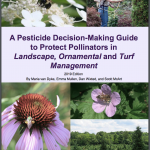 A research group out of Cornell University recently published a pollinator-friendly pesticide decision-making guide for landscape, ornamental and turf management. This is the second publication in a series that also includes a pesticide guide for tree fruit orchards. What is unique about these publications is that they discuss known synergies between chemicals, i.e. instances where the toxicity of one chemical is magnified when it occurs alongside another chemical. For examples, the new guide points out that the fungicide thiophanate-methyl is practically non-toxic alone but becomes highly toxic to bees when used in combination with imidacloprid. These guides are useful for growers, landscape professionals, and home owners who want to make informed pest-management choices. Read the guide here.
A research group out of Cornell University recently published a pollinator-friendly pesticide decision-making guide for landscape, ornamental and turf management. This is the second publication in a series that also includes a pesticide guide for tree fruit orchards. What is unique about these publications is that they discuss known synergies between chemicals, i.e. instances where the toxicity of one chemical is magnified when it occurs alongside another chemical. For examples, the new guide points out that the fungicide thiophanate-methyl is practically non-toxic alone but becomes highly toxic to bees when used in combination with imidacloprid. These guides are useful for growers, landscape professionals, and home owners who want to make informed pest-management choices. Read the guide here.Upcoming Events
Spring Kickoff for Landscapers: UMass Extension's Landscape Education Day
March 26, 2020
Location: Topsfield Fairgrounds, Topsfield, MA
Sustainable landscaping uses multiple management strategies that seek to reduce negative impacts on the environment while maintaining aesthetically pleasing landscapes. Come join us to learn management strategies and practices that you can implement to provide beautiful, functional and environmentally friendly landscapes for your customers. Topics include: how to deal with nuisance wildlife and effective ways to attract and support pollinators in managed landscapes, troubleshooting common diseases of perennials in the landscape, taming the top troublesome insect and mite pests of woody landscape plants, and early season weed management.
4 pesticide contact hours for categories 29, 36, and Applicators License.
Association credits: 5 (cat 2) CFE, 4 ISA, 1 MCH, 2 MCA, and 2 MCLP.
Registration Options and More Details
Other Upcoming Events:
- Second Wednesday of each month - TickTalk with Tick Report, a free webinar series
3/11 - Tick Behavior: Finding Hosts & Feeding webinar - 3/19, 4/1 & 4/15 - Invasive Plant Management Certification Program classes
- 3/10 - Community Tree Conference: Challenges and Opportunities for 2020 - What’s New in Arboriculture & Urban Forestry?
- 3/26 - Spring Kickoff for Landscapers: UMas Extension Landscape Education Day
- 5/19 - Weed Walkabout
- 6/4 - Landscape Pests & Problems Walkabout: Diseases & Weeds
- 6/11 - Ornamental Tree & Shrub ID and Insect Walk
- 6/25 - Landscape & Forest Tree & Shrub Insect Workshop
- 9/9 - Ornamental Tree & Shrub ID and Insect Walk
- 10/26-12/10 - Green School
For more information and registration for any of these events, go to the UMass Extension Landscape, Nursery, and Urban Forestry Program Upcoming Events Page.
Additional Resources
For detailed reports on growing conditions and pest activity – Check out the Landscape Message
For commercial growers of greenhouse crops and flowers - Check out the New England Greenhouse Update website
For professional turf managers - Check out our Turf Management Updates
For home gardeners and garden retailers - Check out our home lawn and garden resources. UMass Extension also has a Twitter feed that provides timely, daily gardening tips, sunrise and sunset times to home gardeners at twitter.com/UMassGardenClip
Diagnostic Services
A UMass Laboratory Diagnoses Landscape and Turf Problems - The UMass Extension Plant Diagnostic Lab is available to serve commercial landscape contractors, turf managers, arborists, nurseries and other green industry professionals. It provides woody plant and turf disease analysis, woody plant and turf insect identification, turfgrass identification, weed identification, and offers a report of pest management strategies that are research based, economically sound and environmentally appropriate for the situation. Accurate diagnosis for a turf or landscape problem can often eliminate or reduce the need for pesticide use. For sampling procedures, detailed submission instructions and a list of fees, go to Plant Diagnostics Laboratory
Soil and Plant Nutrient Testing - The University of Massachusetts Soil and Plant Nutrient Testing Laboratory is located on the campus of The University of Massachusetts at Amherst. Testing services are available to all. The function of the Soil and Plant Nutrient Testing Laboratory is to provide test results and recommendations that lead to the wise and economical use of soils and soil amendments. For complete information, visit the UMass Soil and Plant Nutrient Testing Laboratory web site. Alternatively, call the lab at (413) 545-2311.